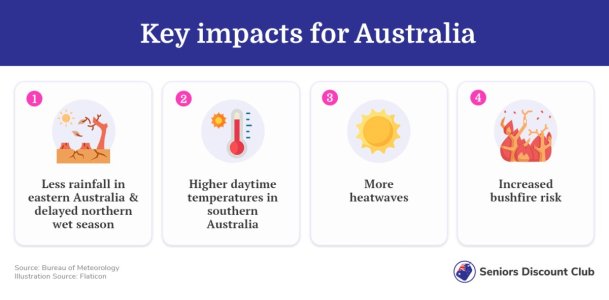Is Australia heading for its hottest summer ever?
By
Seia Ibanez
- Replies 16
Everyone loves summer, as the warmer weather brings an opportunity for us to get out and about and enjoy the great outdoors.
But there's a ‘hot’ surprise on the horizon, and it’s not the good kind.
According to climate experts, Australians are set to face a cruel summer as temperatures will be much higher than expected in the next few months.
Recent data from the Copernicus Climate Change Service (CCCS) has shown that the global temperatures have been 0.1C degrees warmer than in 2016, which holds the record for the hottest year.
The CCSS also said that monthly records have been soaring higher, with temperatures in October at an average surface air temperature of 15.30C—0.85C higher than the average of the past 30 years.

These concerning figures have renewed a 'sense of urgency for ambitious climate action’, said CCSS deputy director Samantha Burgess.
‘October 2023 has seen exceptional temperature anomalies, following on from four months of global temperature records being obliterated,’ Burgess said.
’We can say with near certainty that 2023 will be the warmest year on record, and is currently 1.43C above the pre-industrial average.'
Australia exited its warmest winter on record with a national average temperature of 1.53C above the long-term average.
Similarly, the Bureau of Meteorology also predicted temperatures are ‘very likely to be above average for most of Australia’ from November to January.
The bureau reported, ‘November to January maximum and minimum temperatures are at least 2.5 times more likely than normal to be unusually high (in the top 20 per cent of the climatological record) for most of Australia.’
According to Weatherzone meteorologist Ashleigh Lange, the El Niño and a positive Indian Dipole (IOD) combo could bring abnormally warm and dry weather to the country.
She also said that if these climate drivers develop, the abnormally warm and dry weather will likely increase the risk of fires.
El Niño was already declared on 19 September, where there will be lower-than-average rainfall and high temperatures. Eastern Australia is largely affected by this event, and dry and warmer-than-usual temperatures are felt in the southern parts of the country.
The higher risk of extreme heat across the country and bushfire danger in southeastern Australia have become highly probable.
According to climate science Senior Lecturer from the University of Melbourne, Dr Andrew King, this summer has an even greater risk for heat events.
He said, ‘The unusually hot weather we‘re seeing across southeast Australia at the moment is a warning of the kind of extremes we’re likely to see more of over the next few months.'
‘Coming on the back of consecutive La Niña events, this spring will likely be very different, and we need to be prepared for more heat, drought and fire weather conditions.'

What do you think of this report? What are your ways of beating the summer heat? Let us know in the comments below!
But there's a ‘hot’ surprise on the horizon, and it’s not the good kind.
According to climate experts, Australians are set to face a cruel summer as temperatures will be much higher than expected in the next few months.
Recent data from the Copernicus Climate Change Service (CCCS) has shown that the global temperatures have been 0.1C degrees warmer than in 2016, which holds the record for the hottest year.
The CCSS also said that monthly records have been soaring higher, with temperatures in October at an average surface air temperature of 15.30C—0.85C higher than the average of the past 30 years.

Climate experts predict that temperatures will soar higher than the previous years. Credit: Unsplash
These concerning figures have renewed a 'sense of urgency for ambitious climate action’, said CCSS deputy director Samantha Burgess.
‘October 2023 has seen exceptional temperature anomalies, following on from four months of global temperature records being obliterated,’ Burgess said.
’We can say with near certainty that 2023 will be the warmest year on record, and is currently 1.43C above the pre-industrial average.'
Australia exited its warmest winter on record with a national average temperature of 1.53C above the long-term average.
Similarly, the Bureau of Meteorology also predicted temperatures are ‘very likely to be above average for most of Australia’ from November to January.
The bureau reported, ‘November to January maximum and minimum temperatures are at least 2.5 times more likely than normal to be unusually high (in the top 20 per cent of the climatological record) for most of Australia.’
According to Weatherzone meteorologist Ashleigh Lange, the El Niño and a positive Indian Dipole (IOD) combo could bring abnormally warm and dry weather to the country.
She also said that if these climate drivers develop, the abnormally warm and dry weather will likely increase the risk of fires.
El Niño was already declared on 19 September, where there will be lower-than-average rainfall and high temperatures. Eastern Australia is largely affected by this event, and dry and warmer-than-usual temperatures are felt in the southern parts of the country.
The higher risk of extreme heat across the country and bushfire danger in southeastern Australia have become highly probable.
According to climate science Senior Lecturer from the University of Melbourne, Dr Andrew King, this summer has an even greater risk for heat events.
He said, ‘The unusually hot weather we‘re seeing across southeast Australia at the moment is a warning of the kind of extremes we’re likely to see more of over the next few months.'
‘Coming on the back of consecutive La Niña events, this spring will likely be very different, and we need to be prepared for more heat, drought and fire weather conditions.'
Key Takeaways
- Australia is predicted to experience the hottest year on record in 2023, according to climate experts.
- The Copernicus Climate Change Service (CCCS) has reported that temperatures are consistently breaking records, with October's average air temperature now 0.85C higher than the past 30-year average.
- Australia has just experienced its warmest winter to date, and the Bureau of Meteorology warns that most of Australia will likely face above-average temperatures from November to January.
- An El Nino event was officially declared in September, suggesting high temperatures will accompany lower-than-average rainfall, resulting in an increased risk of extreme heat and bushfires, particularly in southeastern Australia.
What do you think of this report? What are your ways of beating the summer heat? Let us know in the comments below!
Last edited:








